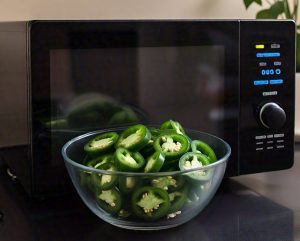Got a sudden cheese craving but short on time? We know the feeling all too well. Our microwave makes it possible to whip up gooey, melty cheesy treats in minutes.
You can create delicious, restaurant-worthy cheese dishes using just your microwave without heating up the whole kitchen or waiting forever.
Here are our favorite quick and easy microwave recipes every cheese fan should try.
Jump To:
Quick Microwave Parmesan Crisps: A Crunchy Delight
We absolutely love making these crispy Parmesan chips when we’re craving something crunchy and cheesy. The best part? They take just 60-90 seconds in the microwave.
From our own experience, freshly grated Parmesan works way better than the pre-grated stuff. The moisture content makes all the difference for achieving that perfect golden crisp.
What I found works best is spreading thin, even layers on parchment paper. We use about 1 tablespoon per crisp, leaving space between each mound. The cheese naturally spreads as it melts.
One mistake I made early on was using too much power. Start at 70% power for 60 seconds, then check every 15 seconds after that. Burnt Parmesan tastes bitter and ruins the whole batch.
These crisps make fantastic low-carb snacks or elegant garnishes for salads and soups. We often make a double batch because they disappear so quickly!
Effortless Cheesy Garlic Bread in the Microwave
Nothing beats the aroma of fresh garlic bread with melted cheese wafting through our kitchen. Making it in the microwave saves us at least 10 minutes compared to the oven method.
I strongly suggest using day-old bread for this recipe. Fresh bread gets too soggy, while slightly stale bread holds up perfectly to the moisture from melting cheese and garlic butter.
Our go-to combination is softened butter mixed with minced garlic and a pinch of Italian seasoning. Spread this mixture generously on each slice before adding your cheese of choice.
What I found works best is covering the bread with a slightly damp paper towel for the first 30 seconds. This prevents the bread from drying out while allowing the cheese to melt evenly.
From my own experience, mozzarella and cheddar blend beautifully together. The mozzarella provides that classic stretch while cheddar adds sharp flavor depth.
Grilled Goat Cheese Salad With Microwave-softened Cheese
We discovered this technique by accident when our goat cheese was too firm to crumble properly. Softening goat cheese in the microwave transforms both its texture and how it distributes throughout salads.
The key is using very short intervals – just 10-15 seconds at 50% power. Goat cheese has a low melting point, and we’ve learned the hard way that too much heat turns it into an unappetizing mess.
What I found works best is removing the cheese from its packaging and placing it on a microwave-safe plate. Let it rest for 30 seconds between heating intervals to allow even temperature distribution.
From my own experience, slightly warmed goat cheese spreads like butter and blends seamlessly with mixed greens, candied nuts, and dried cranberries. The warmth also enhances its tangy flavor profile.
One mistake I made was heating it too long initially. The cheese separated and became grainy. Now we always err on the side of caution with shorter heating times.
Also See: 2-minute Microwave Cinnamon Apple Mug Cereal
Quick Cheesy Broccoli Made in the Microwave
We’ve perfected this quick cheesy broccoli recipe after countless trials in our microwave. It’s become our go-to side dish when we need something healthy but incredibly satisfying.
From my own experience, fresh broccoli florets work much better than frozen ones. Fresh broccoli maintains that perfect tender-crisp texture while frozen tends to get mushy and watery.
What I found works best is cutting the broccoli into uniform, bite-sized pieces. Steam them with just 2-3 tablespoons of water for 3-4 minutes at full power before adding any cheese.
One mistake I made early on was adding cheese too soon. The broccoli wasn’t hot enough to melt the cheese properly, resulting in clumpy, uneven distribution. Now we always steam first, then add cheese.
I strongly suggest using a combination of sharp cheddar and cream cheese. The cheddar provides bold flavor while cream cheese creates that luxurious, velvety coating we all crave.
Cover the dish with a microwave-safe plate during the final 30-second melting phase. This creates a mini steam chamber that helps the cheese melt evenly without splattering all over your microwave.
The Art Of Selecting Cheeses for Microwave Melting
Not all cheeses behave the same way in the microwave, and we’ve learned this through plenty of trial and error. Understanding each cheese’s melting properties makes the difference between creamy success and disappointing failure.
From my own experience, younger cheeses with higher moisture content melt far more smoothly than aged varieties. Fresh mozzarella, mild cheddar, and Monterey Jack are our reliable go-to choices for microwave cooking.
What I found works best is avoiding pre-shredded cheese when possible. Those anti-caking agents prevent smooth melting and can create a grainy texture. Freshly grated cheese melts like a dream compared to the bagged stuff.
I strongly suggest staying away from very hard cheeses like aged Parmesan or aged aged Gouda for melting purposes. These work great for crisps but become tough and rubbery when you’re trying to create smooth, melted cheese sauces.
One mistake I made was using low-fat cheese varieties. They contain less fat and more protein, which means they separate easily under microwave heat. Full-fat cheeses are your best friend for consistent melting.
Cream-based cheeses like brie, camembert, and cream cheese itself are phenomenal for microwave cooking. They maintain their smooth texture and blend beautifully with other ingredients without becoming stringy or lumpy.
Mastering Microwave Settings for Perfect Cheese Melting
We’ve discovered that power level control is absolutely crucial for melting cheese properly in the microwave. High heat might seem faster, but it’s the quickest path to rubbery, separated cheese disasters.
From my own experience, 50-60% power works best for most cheese melting applications. This gentler heat allows the cheese to warm gradually and melt evenly without the proteins seizing up.
What I found works best is using 30-second intervals with stirring between each round. Never microwave cheese for more than 30 seconds at a time without checking and stirring. The texture changes happen quickly.
I strongly suggest covering your cheese with a damp paper towel during melting. This creates steam that helps prevent the surface from drying out while the interior heats through.
One mistake I made repeatedly was microwaving cold cheese straight from the fridge. Room temperature cheese melts much more evenly and predictably. Let your cheese sit out for 15-20 minutes before microwaving.
For dishes requiring multiple types of cheese, add them in order of melting difficulty. Start with harder cheeses that need more time, then add softer varieties during the final heating intervals.
The standing time after microwaving is just as important as the heating itself. Let melted cheese rest for 30-60 seconds before serving. This allows the temperature to equalize and the texture to settle into that perfect, creamy consistency we’re all after.
Time to Get Cheesy in Your Kitchen
We’ve shared our favorite cheesy microwave recipes that’ll satisfy any cheese craving in minutes. From crispy parmesan rounds to melty broccoli goodness, these recipes prove your microwave can create restaurant-quality cheesy dishes. Each one takes less than 10 minutes and uses ingredients you probably already have.
Don’t wait another day to try these recipes! Start with the parmesan crisps – they’re foolproof and incredibly addictive. Once you master the basic techniques we’ve covered, you can experiment with different cheese combinations and create your own signature microwave masterpieces. Your taste buds will thank you for diving into this cheesy adventure.







